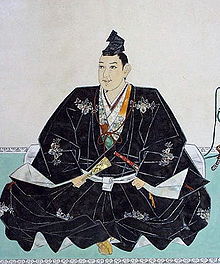Ukita Hideie
This article needs additional citations for verification. (January 2009) |

Template:Japanese name Ukita Hideie (宇喜多 秀家, 1573 – December 17, 1655) was the daimyo of Bizen and Mimasaka provinces (modern Okayama Prefecture), and one of the council of Five Elders appointed by Toyotomi Hideyoshi.[1] Son of Ukita Naoie, he married Gohime, a daughter of Maeda Toshiie. Having fought against Tokugawa Ieyasu in the Battle of Sekigahara he was exiled to the island prison of Hachijōjima, where he died.
Rise to prominence
Hideie's father Naoie was daimyo of Bizen province and initially opposed, but later sided with Oda Nobunaga and Toyotomi Hideyoshi. Naoie died in 1581, and in 1582 Hideie became the head of the Ukita clan. As Hideie was still young, it was Hideie's uncle [Tadaie] who acted as leader of the Ukita army (under Toyotomi Hideyoshi) during the siege of Bitchu Takamatsu Castle in 1582. Nobunaga was assassinated on June 2 of that year, but the siege continued until the castle fell two days later. Hideyoshi raced back to Kyoto, leaving the Ukita clan in charge of Bizen, Mimasaka and newly taken parts of Bitchu provinces. The Ukita were also to keep watch on Mōri Terumoto to the west.
In 1586, Hideie was married to Hideyoshi's adopted daughter, Gohime. (She had been adopted by Hideyoshi from Maeda Toshiie.)
Hideie joined Hideyoshi's military campaigns in Shikoku (1585), Kyushu (1586) and the Siege of Odawara (1590). Following the unification of Japan under Hideyoshi, Hideie joined the Korean campaigns, returning in 1598 to serve as one of Hideyoshi's five counselors, along with Maeda Toshiie, Uesugi Kagekatsu, Mōri Terumoto, and Tokugawa Ieyasu.
Battle of Sekigahara
Hideyoshi died in 1598, leaving his five-year-old son Hideyori as his successor and Tokugawa Ieyasu moved to take control. Hideie contributed 17,000 men to the Toyotomi army at the Battle of Sekigahara but they were defeated after many of their "allies" defected to the Tokugawa side. One of these defectors was Kobayakawa Hideaki, who was granted Okayama Castle and surrounding Ukita territories as the spoils of war.
Hideie escaped from the confusion of the battlefield, but was later found and exiled to the island of Hachijōjima, along with several supporters, including his two sons and their nurse(s?). Hideie's wife sought refuge with the Maeda clan and was able to correspond and send gifts (rice, sake, clothing) to her husband and sons from there.
Hideie eventually outlived his wife and all of the sengoku (warring states) era samurai. He was offered a conditional pardon after Ieyasu's death, but declined and never returned to the mainland. His wife had died, the Toyotomi were defeated, there was no place to return to, his sons had fathered children on Hachijo, and the Shogunate was to be inherited by members of the Tokugawa clan.
There is no evidence to suggest that Hideie fathered any further children himself, but many of his sons' descendants emigrated back to the Japanese mainland when a full pardon was granted at the end of the Tokugawa era.
Notes
- ^ Kodansha. (1983). "Ukita Hideie," in Kodansha Encyclopedia of Japan, Vol. 8, pp. 137-138.
References
- Kodansha. (1983). "Ukita Hideie," in Kodansha Encyclopedia of Japan. Tokyo: Kodansha. OCLC 233144013
